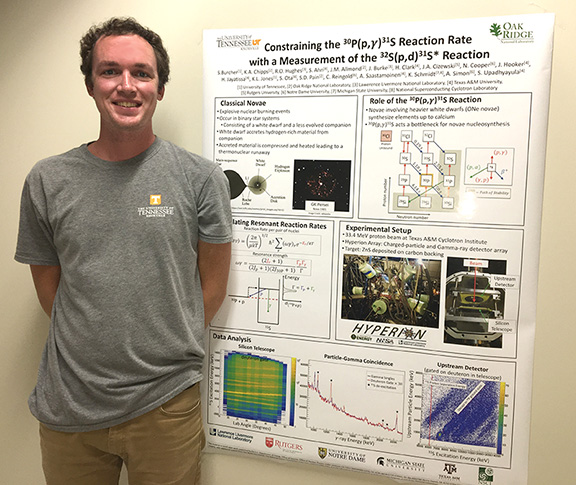Double Awards for Grad Student Sean Burcher

Physics Graduate Student Sean Burcher toured this world this summer, presenting his research on classical novae and winning two awards in the process.
As Burcher explained, "classical novae are thermonuclear explosions that occur on the surface of white dwarfs."
A white dwarf is a dense star that has exhausted its fuel supply of hydrogen and given in to gravity, collapsing on itself. The explosions on its surface produce elements like the lithium we use in batteries and smart phones. But what of the heavier elements?
Burcher’s work focuses on a specific proton capture reaction rate: 30P(p,γ)31S. He described how this process “acts as a bottleneck for the nucleosynthesis of heavier elements in classical novae.
"Currently it is poorly constrained experimentally and as such is a large source of uncertainty in the relative abundance of elements produced in classical novae," he said. "If we can reduce this uncertainty we can use observations of classical novae to better understand the properties of the underlying white dwarfs."
Burcher first became involved with this research through an invitation from Dr. Kelly Chipps of the Experimental Nuclear Astrophysics group at Oak Ridge National Laboratory. Last fall he went to Texas A&M University where he set up all the detectors for the studies—including mounting, cabling, and recording calibration data with both charged particle and gamma-ray detectors. As the two experiments ran he made sure the equipment was working properly and useful data was being duly recorded.
The second experiment was the basis for his presentation "Constraining the 30P(p,γ)31S Reaction Rate, via a Measurement of the 32S(p,d)31S* Reaction," which he gave as a poster at two conferences this summer. The first was the 10th International Conference on Direct Reactions with Exotic Beams (DREB2018) held this June in Matsue, Japan. Burcher was recognized with the Asian Nuclear Physics Association & Association of Asia Pacific Physics Societies Division of Nuclear Physics Award for Young Scientists. The award was given to one theoretical and one experimental poster presentation. In August he travelled to Michigan State University for the Nuclear Structure 2018 (NS2018) meeting where he won the second place prize for best poster presentation.
Burcher is working to analyze the data recorded from the experiments for publication as well as for his doctoral dissertation.
The research was made possible by support from the US Department of Energy Office of Science (Office of Nuclear Physics), the National Science Foundation, Oak Ridge National Laboratory, and The Welch Foundation in Houston, Texas.